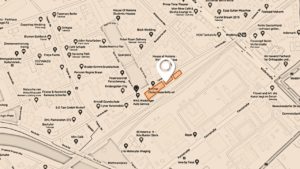In der Lynarstraße im Stadtteil Wedding ist bereits Ende 2018 ein innovatives Wohnprojekt fertiggestellt worden, das wegweisend für Wohnungsbauprojekte der Zukunft sein könnte.
Eines der größten Holzhäuser Deutschlands ist hier entstanden, direkt an den Gleisen der Ringbahn. Trotz der unmittelbaren Nähe zur S-Bahn ist im Wohnhaus selbst vom intensiven Ringbahnverkehr fast nichts zu hören.
Eines der größten Holzhäuser Deutschlands
Dafür ist die Anbindung an den öffentlichen Nahverkehr umso besser. Nur wenige Gehminuten entfernt liegt der U- und S-Bahnhof Wedding, der einen S-Bahn- und U-Bahn-Anschluss bietet.
Das in Berlin ansässige Architektur- und Ingenieurbüro Schäferwennigerprojekt GbmH hat den Bau konzipiert und umgesetzt. Die Gesellschaft wurde vom Bauherren, der Wohnungsbaugenossenschaft „Am Ostseeplatz“ e.G., mit dem Bau beauftragt.
In unmittelbarer Nähe zum S- und U-Bahnhof Wedding
Holz entwickelt sich mehr und mehr zu einem Standard-Baustoff für moderne Wohn- und Gewerbebauten. Der Brandschutz ist beim heutigen Stand der Technik kein Problem mehr und mit einer Lebenszeit von 80 bis 100 Jahren ähnlich lange haltbar wie ein übliches Massivhaus.
Insgesamt wurden 3.700 Kubikmeter Holz, vor allem Fichte und Douglasie aus Deutschland und Österreich, verbaut. Da die Bauteile überwiegend fertig vormontiert angeliefert wurden, wuchs der Bau verhältnismäßig schnell in die Höhe. 98 Wohnungen und weitere sieben Gewerbeeinheiten sind in den Holzhäusern entstanden.
98 zum Teil geförderte Mietwohnungen sind entstanden
Besonders an dem Neubau war auch, dass die künftigen Mieter ihr Haus mitgestalten und bei der Entstehung beobachten konnten. Regelmäßig gab es für sie Baustellenbesichtigungen.
Die Hälfte der Wohnungen wurde an Mieter mit Wohnberechtigungsschein für 6,50 Euro pro Quadratmeter netto kalt vermietet. Die anderen Wohnungen kosten acht bis neun Euro pro Quadratmeter. Nur die Bewohner im obersten Geschoss zahlen 12 bis 13,50 Euro pro Quadratmeter.
Günstiger Baugrund, der direkt am S-Bahnring liegt
Die niedrigen Mieten sind möglich, weil der Bauherr 2,5 Millionen Euro Fördermittel aus dem Senatsprogramm „Experimenteller Geschosswohnungsbau“ im Rahmen des Sondervermögens Infrastruktur der wachsenden Stadt (SIWA) bekommen hat.
Zudem war der Baugrund ausgesprochen günstig, Da das einstige Gewerbegrundstück in der Lynarstraße direkt an der S-Bahntrasse lag. Doch die Wohnungsbaugenossenschaft „Am Ostseeplatz“ e.G. kaufte das unattraktive Grundstück, um dort das Holzhaus zu errichten.
In Lynarstraße in the Wedding district, an innovative residential project was completed as early as the end of 2018, which could be groundbreaking for housing projects of the future.
One of the largest wooden houses in Germany has been built here, directly on the tracks of the Ringbahn. Despite the immediate proximity to the S-Bahn, there is almost no sound of the intensive ring train traffic in the residential building itself.
ONE OF THE LARGEST WOODEN HOUSES IN GERMANY
But the better the connection to public transport. Only a few minutes’ walk away is the U-Bahn and S-Bahn station Wedding, which offers a suburban train and subway connection.
The Berlin-based architecture and engineering firm Schäferwennigerprojekt GbmH designed and implemented the construction. The company was commissioned with the construction by the client, the housing association “Am Ostseeplatz” e.G.
IN CLOSE PROXIMITY TO THE S- AND SUBWAY STATION WEDDING
Wood is increasingly becoming a standard building material for modern residential and commercial buildings. Fire protection is no longer a problem with today’s state-of-the-art technology and, with a lifetime of 80 to 100 years, is as durable as a normal solid house.
A total of 3,700 cubic meters of wood, mainly spruce and Douglas fir from Germany and Austria, were used. Since most of the components were delivered pre-assembled, the building grew relatively quickly. 98 apartments and a further seven commercial units were built in the wooden houses.
98 PARTIALLY SUBSIDIZED RENTAL APARTMENTS WERE BUILT
Another special feature of the new building was that the future tenants were able to help design their house and watch it being built. There were regular site visits for them.
Half of the apartments were let cold to tenants with a residential entitlement certificate for 6.50 euros per square meter net. The other apartments cost eight to nine euros per square meter. Only the residents on the top floor pay 12 to 13.50 euros per square meter.
LOW-COST BUILDING GROUND, LOCATED DIRECTLY ON THE S-BAHN RING
The low rents are possible because the developer has received 2.5 million euros in subsidies from the Senate’s “Experimental Apartment Construction” program under the Infrastructure of the Growing City (SIWA) special fund.
In addition, the building site was extremely favorable, since the former commercial property in Lynarstraße was located directly on the S-Bahn route. But the housing cooperative “Am Ostseeplatz” e.G. bought the unattractive plot of land to build the wooden house there.



3 Pingbacks